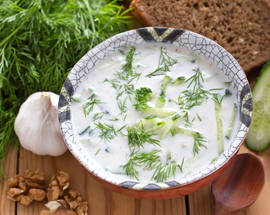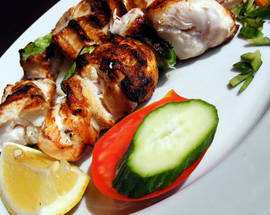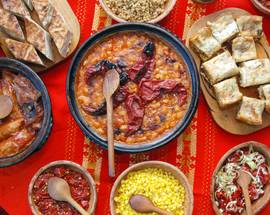What to eat in Bulgaria
more than a year agoBulgarians always start the meal with a salad, usually accompanied by a glass of rakia, the local spirit made of grapes or plums, or maybe in the summer months a mastika, an aniseed based spirit similar to the Greek ouzo.
SALADS
These are some of the most popular salads worth trying. Most are served without a dressing: oil and vinegar can be added to one’s taste.
shopska salad: This is the Bulgarian salad, made with chopped tomatoes, cucumber, covered in grated sirene (salty sheep or cow’s cheese) and parsley. Sometimes it also includes fresh or baked peppers and onion.
snezhanka or mlechna salata: cucumber finely chopped in strained yogurt, with garlic and crushed walnuts. Sometimes in the winter months, pickled gherkins are used as a substitute for the rather expensive and watery cucumbers.
chushki salad: freshly roasted peppers, skinned and marinated with oil, slivers of garlic and plenty of fresh parsley.
kyopoulu: aubergines are roasted whole, the flesh is then scooped out and blended with a couple of roasted and skinned peppers, plenty of fresh garlic and parsley and a little oil.
turshiya: a winter salad of pickled vegetables, including green tomatoes, cauliflower, carrots and peppers
russka salata: another winter favourite with small chunks of potato, carrots and gherkins in mayonnaise.
STARTERS
A hot starter may follow: this could be braised offal, such as liver or chicken hearts, or even fried brains, but if like most foreigners you squirm at the thought, do not worry there are plenty of delicious vegetarian options that can also substitute a main course.
chushki byurek: a pepper stuffed with cheese and herbs and fried in breadcrumbs.
podlucheni tikvichki: fried courgette slices covered with a garlicky yoghurt and dill sauce.
sirene po shopski: white cheese baked in a ceramic pot, topped with an egg and chilli pepper.
mish mash: scrambled eggs with tomatoes, red peppers and sirene.
surmi: either stuffed cabbage or vine leaves, which can be with meat or vegetarian.
pulneni chushki: stuffed peppers, usually with mince meat and rice, often served with a Bechamel sauce.
SOUPS
shkembe chorba: a real favourite – tripe soup seasoned with garlic in vinegar and often eaten at breakfast time.
tarator: a cold yogurt soup with chopped cucumber, dill and plenty of garlic. A real hot summer’s day favourite. Sometimes chopped walnuts are also added.
bob chorba: bean soup, delicious and filling.
supa ot kopriva: soup made with the young leaves of the stinging nettle plant, said to be very rich in iron. Similar to spinach soup, but a little sharper in taste.
MAIN COURSES
This to a Bulgarian usually means meat.
Bulgarians do not have a strong beef-eating culture so most main course dishes are chicken or pork-based. Beef dishes are usually referred to as teleshko (veal) and can be a bit tough. Although the general advice would be to avoid veal, the quality of meat served in the better restaurants is very acceptable. Fresh lamb continues to be seasonal. A particular favourite is the Velikdensko agney (Easter Lamb) or St. George’s Day lamb which is a whole roast lamb stuffed with rice and its own innards. Grilled meats are also very popular and are usually served with French fries.
kyufteta: spicy meat balls, burgers.
nervosni kyufteta: very spicy burgers.
kebapcheta: mild mince meat burgers in sausage shape.
shish: grilled skewer with chicken or pork meat, sometimes with onions, mushrooms and peppers (when it is called shashlik).
purzhola: chop, usually pork, but can be also a flattened piece of meat.
kavarma: meat stew cooked for many hours and served in a traditional small earthenware pot, topped with a fried egg.
gyuvech: tasty vegetable stew, using a variety of vegetables, including onions, carrots, peas, potatoes, cabbage. Meat can also be added.
moussaka: potatoes and mincemeat cooked in layers in the oven, similar to the Greek moussaka but without the aubergine.
svinsko (pile) sus zele: pork or chicken slow-baked in the oven with finely chopped cabbage and tomatoes. In the winter months this dish is popular using pickled cabbage (kiselo zele)
Unfortunately, there is little choice in fresh fish beyond pasturva (trout) and some seasonal Black Sea fish. If holidaying at the Black Sea you might like to try popcheta, a local fresh fish fried whole.
In season you can also find Black Sea kalkan (turbot), skumriya (mackeral), lefer (very tasty blue fish) and akula (shark). The fish is rarely imaginatively prepared and often is simply fried and served with slices of lemon. The ubiquitous byala riba or hek (hake) are both frozen and are not to be recommended.
SNACKS
banitsa: a flaky pastry usually filled with sirene (white cheese) that is unforgettable when homemade but frequently greasy when bought from a shop. Served as a traditional breakfast or daytime snack. Variations of the filling include: spinach, leeks, or pumpkin and walnuts for a sweeter option.
tutmanik: very similar to banitsa but made with a yeast dough.
mekitsi: doughnuts, not round with holes in the middle but random shapes, dusted with icing sugar.
gevrek: the closest thing to a bagel, usually sold out of large paper bags on street corners.
kiselo mlyako: sour milk or yogurt is another staple in the Bulgarian diet. It is widely claimed that yogurt originated in Bulgaria using the live bacillus bulgaricus bacteria and that the local varieties are still the best in the world. Usually made from cow’s milk, one can also find yoghurt from buffalo or sheep’s milk.
Dried salamis such as lukanka, and pasturma are often served sliced on plates together with other ‘nibbles’ such as nuts and olives as accompaniment to drinks.
DESSERTS
Bulgarian cuisine, especially in restaurants, is not very strong when it comes to desserts. Most rely on palachinka (pancakes, usually with honey and nuts) or sladoled (ice cream).
Pastry shops (sladkarnitsa) offer a large variety of cakes and sweets including baklava (filo pastry filled with nuts and soaked in sugar syrup), tulumbichki (fried dough sticks in syrup) and garash torta (chocolate cake).
Don’t be surprised if Bulgarians eat some things that we would consider unacceptable in the western world. Lamb heads (with teeth intact!) are a delicacy as are brains, hearts, pigs’ trotters and ears, and various other unmentionables. Another truly acquired taste is boza, a thick malt based drink with a distinct smell.
Regional Variations
As in most countries Bulgarian cuisine also has its regional specialities. Kapama is a traditional stew from the Pirin region, said to contain at least seven types of meat cooked slowly with onions in a large earthenware pot. The Pirin region around Bansko is also well known for a variety of special sausages like Banski Starets.
The Rhodope region is also well known for its specialities, its salads and starter use local dairy products and herbs and spices as in the Polyanska Salata made from strained yogurt combined with spinach, sorrel, garlic and dill. Rodopski Katuk is a spicy curd cheese flavoured with peppers. Patatnik is a fried thick potato cake similar to the Spanish tortilla.





Comments